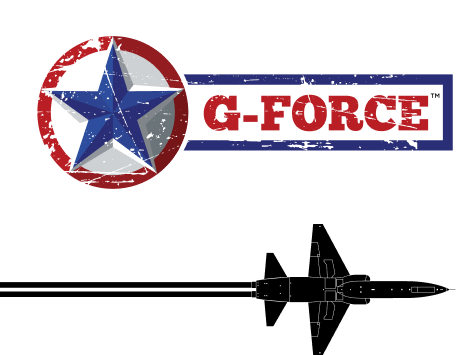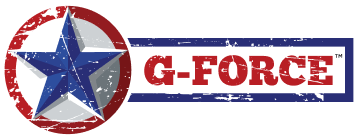How to Stripe an Airfield
This article originally appeared on ASPHALTPRO Magazine.
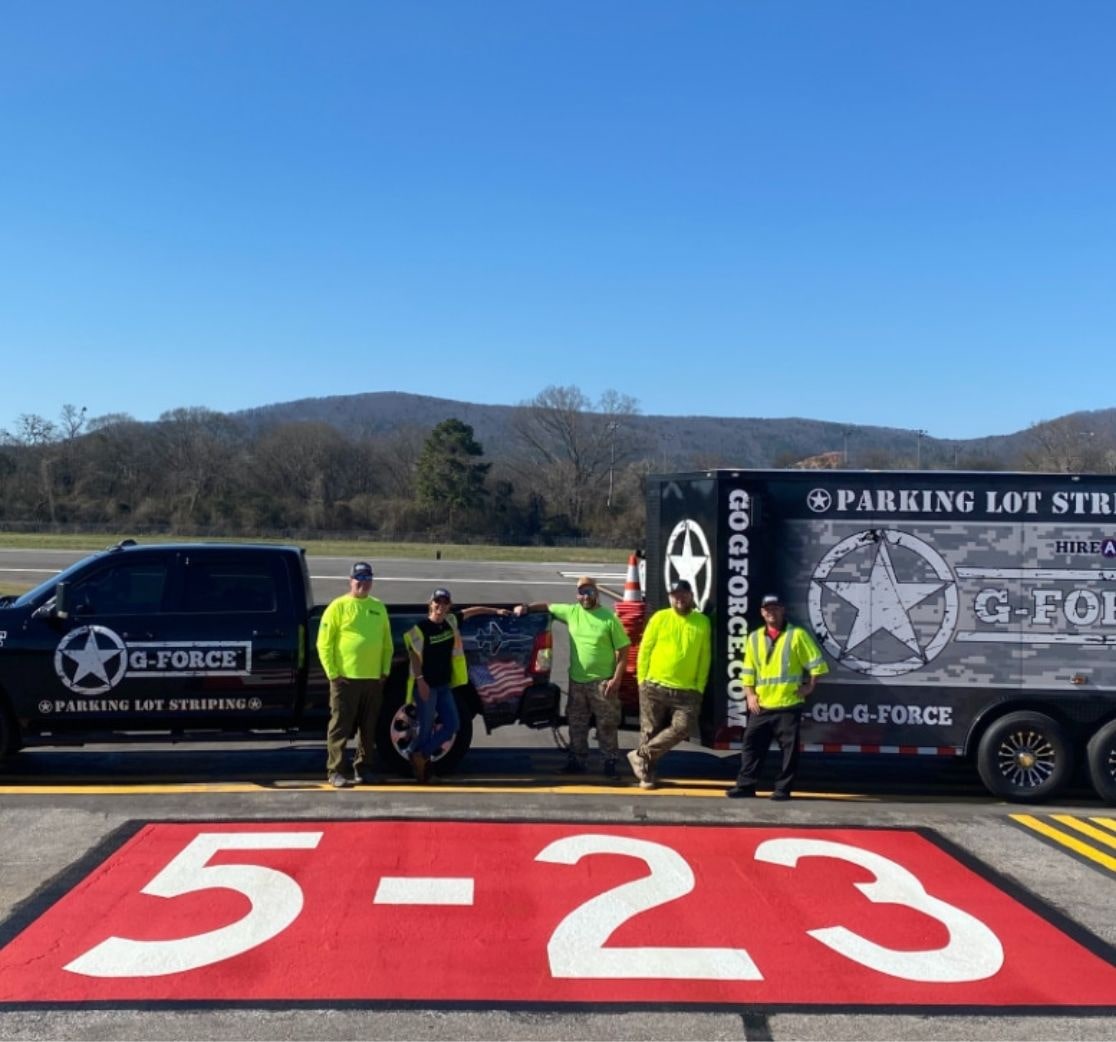
Jack Child understands the importance of quality and precision when it comes to airfield markings. He was a military and airline pilot for 39 years before founding G-FORCE, a pavement marking company with franchises in 37 locations around the country, as its CEO in 2017.
“I spent a lot of time looking at airfield markings (and unknowingly doing my best to wear them down), so I’ve come to know the difference between quality workmanship and sloppy workmanship quite well,” Child said. When the company decided to break into airport markings, he wanted to make sure the crews were equipped with the training they’d need to succeed.
Child began investigating airfield marking training courses and came across an offering from Sightline, Culpeper, Virginia, a consulting company specializing in airfield markings that has worked with some of the United States’ busiest airports and pre-eminent airfield marking contractors.
G-FORCE sent three of its franchise owners to Sightline’s Airfield Marking Professional Symposium in the fall of 2021. “They enjoyed the class so much, we sent several more owners to the following course,” Child said, adding that they’ll be sending a handful more to Sightline’s symposium in October. “Soon, more than one-third of our owners will be trained and certified for airfield markings.”
In one of those rare but happy accidents, just as G-FORCE’s first batch of franchise partners had completed the training course, northeastern Alabama’s Anniston Regional Airport reached out to G-FORCE’s North Alabama franchise to ask if they performed airfield markings.
“The owner of our North Alabama franchise, Rob Young, hadn’t been trained on airfield markings yet, but he was able to collaborate with one of our other owners, Steven Hull of G-FORCE Baltimore, who had been through the course and was able to travel to Alabama to oversee the project,” Child said. “The timing worked out perfectly.”
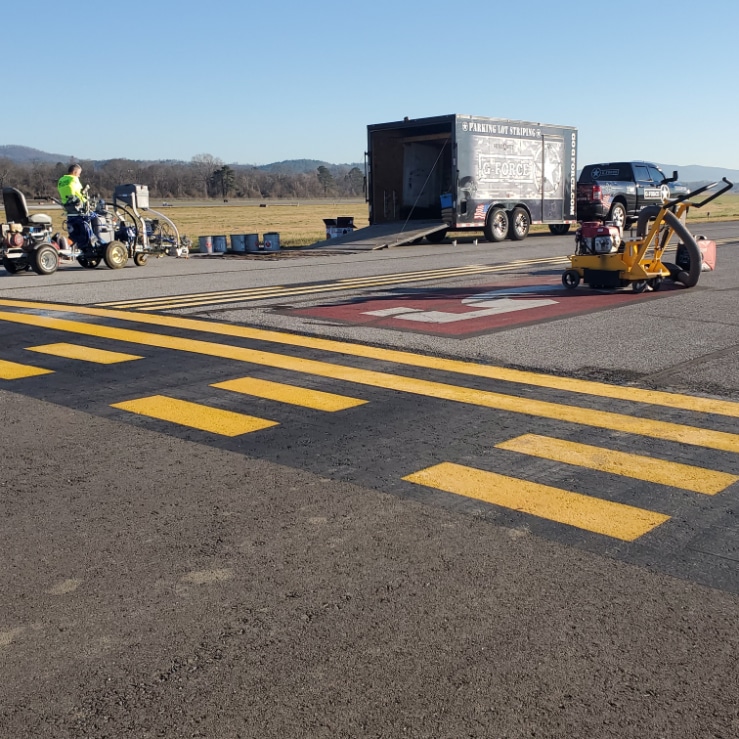
The job also just happened to be in the niche G-FORCE was hoping to carve for itself in airport markings of private and regional airfields. “We see a real opportunity in that particular space because the projects are often too small to attract the large companies specializing in airfield markings,” Child said. That leaves a gap in the market that an organization like G-FORCE can fill using much of the same equipment and crews for its existing book of work, under the guidance of its newly trained certified airfield professional franchise partners. “This is a great growth opportunity for our brand because of our large geographic reach and our ability to bring together multiple teams of trained professionals to complete these jobs.”
Ultimately, G-FORCE hopes to certify at least two-thirds of their franchise owners with airfield marking training. “That would give us very broad, local coverage around the country.”
Although the ability to send staff around the country when needed is a benefit for G-FORCE’s airfield marking operations, Child said it’s a strategy they use on projects of all kinds. “We send folks all over the country to help each other,” he said. “No franchise partner is ever alone and there’s never a project so big they have to turn it down.” For example, a large warehouse in Upstate New York, which required crews from Tampa and New Hampshire to travel to assist.
Train to Gain A Competitive Edge
As G-FORCE’s interest in the airfield marking niche grew, Child was surprised to learn the Federal Aviation Authority (FAA) does not require airfield marking training. “As an airline captain I often joked that my real job was ‘aviation attorney’ since so much of each flight involved legalities as much as engine thrust to get my jet legally and safely off the ground,” Child said. “I was very surprised to learn you don’t need to be certified to be awarded a project on an airport. But, your work does have to meet the specifications of installation, which are very rigid, and that’s why we chose the path of getting properly trained from the beginning.”
According to Mike Speidel, vice president at Sightline, the FAA came out with guidance in 2019 that said those performing maintenance activity surrounding airport markings should be trained. In government terms, he added, “should is a recommendation, while shall is a requirement.”
“Airports with commercial passenger traffic coming through have very high standards,” Speidel said. “Just because you can paint a 4-inch line or a 6-inch line, doesn’t mean you can paint airfields.”
All the owners of G-FORCE’s 37 core locations are military veterans, several with aviation backgrounds. “Our team understands the impact of their workmanship in something as critical as a runway operation,” Child said. “When we expanded into this market, we wanted to make sure our team had the knowledge to perform these critical jobs the right way. And, frankly, we’ve found the FAA inspectors and field managers like working with veterans.”
Child said G-FORCE will always have a certified professional on its airfield marking projects, while also utilizing the projects as an opportunity to share those skills with other franchise owners and their local crews. “We have the crews in place who already know how to perform most of these tasks and just need a supervisor and project manager to make sure they’re performing the work in compliance with the specifications for that particular project,” he said.
An Alabama Airport
That’s exactly what happened when Hull and business partner Harry Rowan joined Young for the airfield marking job at Anniston Regional Airport in March 2022. The airport services regional passenger traffic and airborne firefighting units, and is a major hub for visitors to the Talladega Speedway.
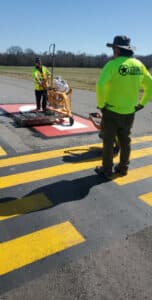
Young had performed work for the city of Anniston in the past when the airport reached out to him to see if he was interested in doing their airfield markings. “Rob wasn’t certified yet, so he asked if we’d be interested in helping,” Hull said. “We were excited to help him, but also to get our feet wet since it was our first airfield job.”
The specifications are the most challenging aspect of airfield markings, Child said. “These projects can be fraught with peril,” he said. “If you don’t apply it to spec, you’ve opened up a can of worms that might require additional applications or even removal, which is both costly and not a good look.”
Hull said one of the most valuable aspects of the training program was the manuals and reference materials he was able to return to as needed and the ability to contact Sightline with questions should any arise.
Traffic control was another area in which the training was particularly useful, since it is so different from traffic control for G-FORCE’s other types of work.
If there is a single runway, as was the case in Anniston, the airport will shut down and publicize a Notice to Air Mission (NOTAM) of the airport’s closure, which pilots check for when plotting their flights. Then, the airport puts a large x-shaped sign on the runway and broadcasts the airport’s closure from the tower to approaching aircraft. The signage and broadcast would also apply if certain runways of a multiple-runway airport were closed for marking.
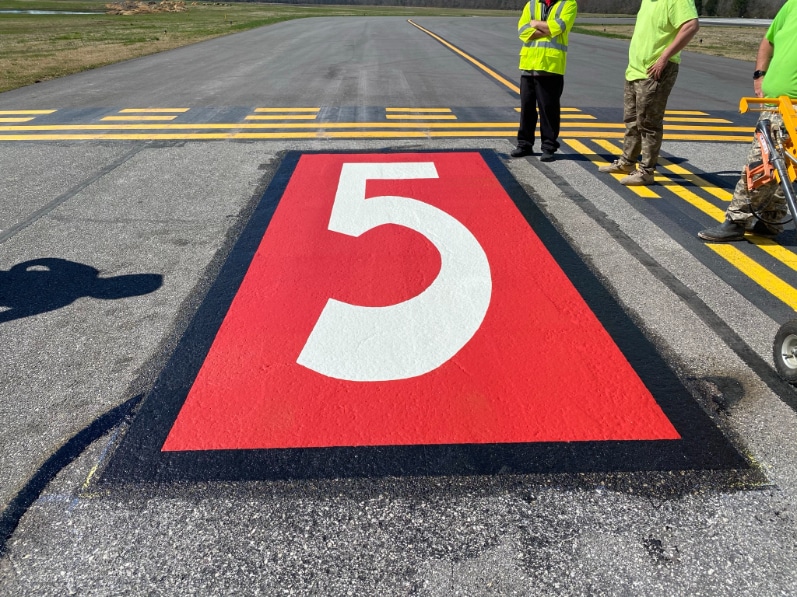
Once it was safe to begin performing the work on Anniston’s airfield, the G-FORCE crew set to work removing the old thermoplastic with its Smith rotary grinders and collecting the dust debris to prevent Foreign Object Damage (FOD), a real threat to all aircraft and particularly jets. After properly preparing the surface to maximize adhesion, it was time to apply new thermoplastic and re-stripe the taxiway.
According to Child, the markings on the taxiways are more detailed than the runways. “The runways primarily have rectangular bars with numbers, but taxiways have turns, curves, checkerboard patterns, skip lines and other markings that require much more skill,” he said, adding that the specific designs are outlined in the project specifications.
The FAA regulates paint color codes and G-FORCE was able to use their standard Graco line striping equipment with on-board computers and lasers, but the use of reflective beads was something new to this crew.
Understanding how to apply the beads so the project passes the FAA’s retro-reflectivity test was a top takeaway for Hull from the Sightline training.
One of the lessons Speidel sees as most valuable from Sightline’s course relates to calibration of the equipment using a test strip. “It’s key to identify all the variables—how fast you can go, what’s the pressure of the machine, the tip size to be used, the pavement you’re working with—to get the right paint thickness and to apply the right number of beads in a given time frame,” he said. “That calibration process is one thing that most contractors attending our course haven’t done much, if at all.”
Ensuring the project passes the retro-reflectivity test is also a concern for the thermoplastic markings. “You have to be extra cautious to heat the thermoplastic markings to the proper temperature and no higher, so the glass beads adhere but don’t sink in too far that you won’t pass the reflectivity test,” Hull said. He stresses the importance of keeping the heater moving to avoid overheating the thermoplastic and checking on the bead depth as you go.
Since the Anniston Regional Airport was G-FORCE’s first airfield marking job, they brought in technical support from their preformed thermoplastic supplier, Preform LLC, St. Augustine, Florida. “Two of Preform LLC’s owners, Susan Wacha and Steve Makosch, walked us through the job to make sure we were applying the thermoplastic correctly,” Hull said.
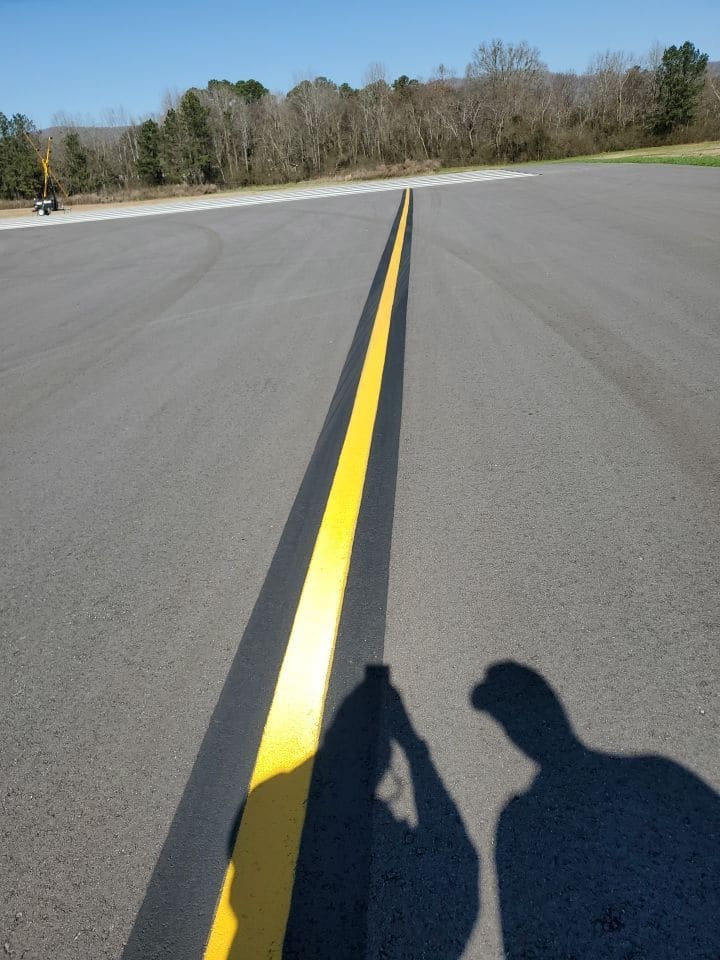
One common issue they experienced was that the airport had some areas where the pavement was cracked, which they filled with a rubber type crack filler. “In order to ensure proper aesthetics on the final markings, the crack filler was heated to level out inside the crack and the crew scraped away any excess protruding filler,” Wacha said. “The outcome was a pristine marking without the interference from the filler beneath it.”
Otherwise, the job went perfectly. “The city was very happy with it and we passed the FAA inspection, so I’d consider that a big win for our first time,” Hull said.
Next for the Niche
Already, G-FORCE has fielded quite a few calls about their expansion into airfield marking, and has performed two additional projects in 2022.
As G-FORCE’s airfield marking operations increase, Child said they anticipate needing bigger, more advanced striping equipment for striping and dispensing reflective beads and larger heaters for applying thermoplastics. Several of its franchises are uniting together to make those investments. For example, Hull and Young plan to team up to buy airport-specific equipment to share between their franchises.
Hull is also taking action to attract more of this work. Since he is currently working toward his private pilot’s license, Hull frequently finds himself at the types of airports for which G-FORCE is hoping to perform work.
“Now that we’re doing airfield markings, I have a whole new perspective when I’m looking down at an airport,” he said, finding that he often makes note of thermoplastic that needs to be replaced or dirty hold bars. “I’m taking pictures from the sky of any deficiencies I see as I approach these airports and then calling them to offer an estimate.”
With each airfield job, G-FORCE strives to pursue this new niche strategically. “We aren’t going after O’Hare International,” Child said. “We’re taking baby steps, making sure we can perform smaller regional airports to a high standard. As we do, I think this niche is going to take off for us (pun intended) and open up new opportunities for our teams around the country.”
Setting Sights on Airfield Marking Training
Sightline has been offering airfield marking training for 15 years, but launched its Airfield Marking Professional Symposium in 2018. Since then, roughly 2000 people have participated in the symposium. The symposium is held two or three times per year, usually in different locations to make it more convenient for contractors and airports around the country.
Sightline also performs around 20 private trainings per year, for example, a recent training Speidel put on at Dallas/Fort Worth International Airport. The benefit of private training, Speidel said, is the opportunity for hands-on training using the crew’s own equipment. “That’s something 95% of our private customers opt for, so we can put into practice what they’ve learned in class.”
Besides the hands-on training, the public and private training covers the same subjects, ranging from traffic management and specifications to surface preparation, calibration, achieving reflectivity and the inspection process.
An emerging trend for the company is what Speidel calls semi-private training, where smaller airports hire Sightline to train their staff and then invite nearby airports, consulting engineers and area contractors to attend for a fee. Speidel just put on a training of this kind at Colorado Springs Municipal Airport, where 10 state airports were in attendance, and has also performed this type of training for Nashville International Airport and Palm Beach International Airport, among others. “Semi-private training helps them include all the people who contribute to the quality of that airport’s airfield markings.”
Sightline also plans to launch an online version of its airfield marking training course in 2023.
Articles that may interest you
Veterans are in the Driver’s Seat
of the Franchise Industry
Jack Child explains his reasoning behind why veterans are sought out after in the franchise world and the growing possibilities available.
FIELD OPS™ Featured in Veterans and Franchising Magazine
Read up on why a FIELD OPS™ franchisee chose to join a franchise built exclusively for veterans.
G-FORCE Lands First Airfield
Striping Project in Alabama
After discovering the need for high-performing striping materials at airfields, G-FORCE took to learning more about airport pavement markings and landed our first airfield striping project in Alabama.
